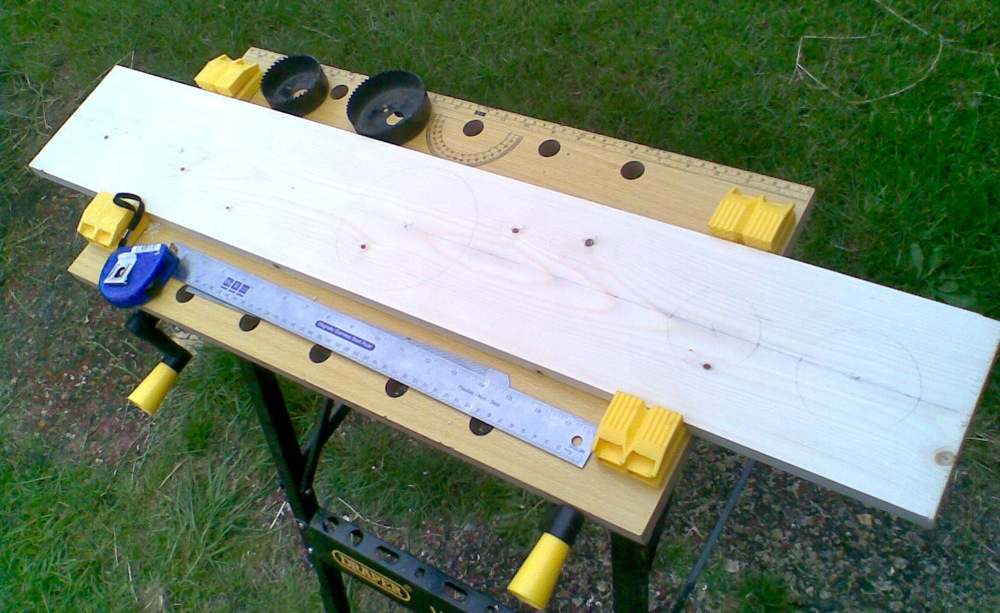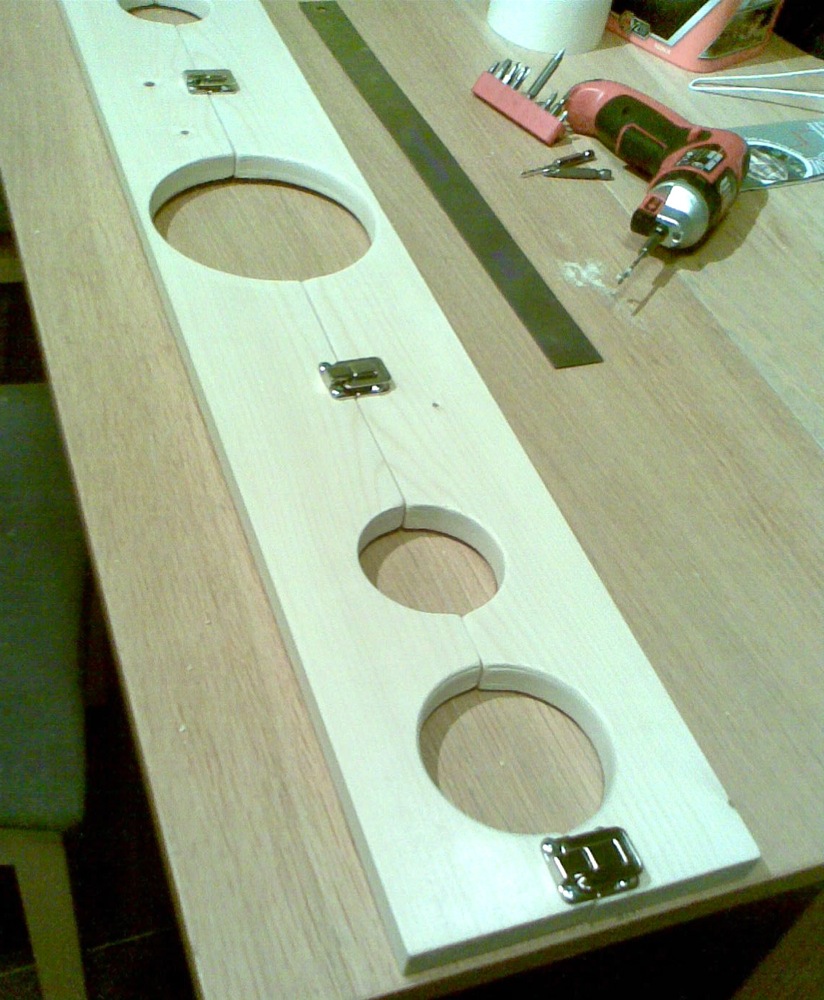The classic wooden stocks are a popular restraint in BDSM play. Whether it is floor standing stocks of a simple plank of wood to clamp the victims’ limbs in. Buying a set of bondage stocks can be a costly affair, yet with a little time and some basic carpentry skills, it is not hard to construct your own bondage stocks.
Building your own bondage stocks allows you to customize them as you see fit, tailoring them for you submissives’ physic, play preferences or with whatever additions you find useful in your BDSM scenes.
In this guide I will be showing you how to make you own simple bondage stocks to clamp in place your submissives’ ankles, wrists and/or neck.
Materials & Tools Required
- 1 Plank of wood. Length of your choosing, but will need to be at least 145cm wide to cater for neck.
- 30 cm (approx.) of dowel, 6-8mm diameter.
- Small toggle catches, preferably four, but two will suffice.
- Hole saw drill bits (I used 64mm, 76mm and 127mm diameters).
- Drill bit to match dowel diameter.
- Sandpaper, selection from coarse to fine.
- Drill, saw, screwdriver, rule etc.
Marking Out the Design
The first thing to do, is cut down you plank of wood to the desired length. Longer will allow you to spread your submissives’ limbs farther apart.
I suggest you lie your submissive down and measure the distance between their limbs, whilst they’re in the position you’d like to clamp them in. But do untie them afterwards, this project might take a while. I opted for a length of 90cm.
Next you need to mark on your plank where you want the holes. Start by dividing the plank in half-length ways, then space the holes along this line. Ensure you maintain at least 3cm gap between edges and each hole, otherwise strength will be compromised and your submissive may break free.
3cm also left room for the smallest toggle catches I could find too. For the wrist holes, I used a 64mm diameter hole, for the ankles a 76mm hole and 127mm for the neck.
I chose these values, simply because they were the sizes of the hole saws I had in my set, but you need not be quite so exact. I placed the ankle holes nearest to the edge, rather than the wrist holes, to spread my submissives’ legs more.

Cutting Out
Once you have marked out your design, go back and measure it all again. Remember – ‘measure twice, cut once’, you don’t want to screw it up. A good dominant is not slap-dash when it comes to the well-being of their submissive.

Go easy with the hole saws, they can be tough on the drill as they bite in. Clamp down your plank and brace the drill against yourself, it can easy snap, spinning the plank into you or causing the drill to twist and strain your wrist.

Cutting Plank into Two Halves
Next, we cut the plank into the two halves that will clamp together. Simply cut along the center line you drew on the plank. I used a plain hand saw, but feel free to use a jigsaw, band saw etc. if you have one at hand.

Sanding Down
The next step is to give the two halves a really good sand down. Start with a coarse grade paper, then work up to fine. I found the hole saws cut very rough holes, requiring a lot of sanding to get them nice and smooth. Take your time and be thorough, as much as you want to hurt your submissive, splitters just aren’t sexy.
Dowel Pegs
To ensure the two halves come together neatly and securely, I used four dowel pegs. These locate the two halves to stop movement and unwanted pinching of your submissive. For my design, I opted for pegs of 80mm length and 8mm diameter.
Simply mark where you want the pegs and drill the holes in each half to match. I deliberately put two pegs asymmetrically to aid putting the two halves together the correct way around.

Finally glue the pegs into one half of the stocks. Then smooth sand the protruding half, giving the dowel a nice rounded smooth head. You might also find it helps to make the peg holes in the other half ever so slightly larger than the pegs, to ensure the two halves slide together nice and easy.
Attaching Toggle Catches
Next, we attach the toggle catch halves to the two halves of the stocks. I opted for four, to ensure the two halves are secure and don’t flex, causing unwanted pinching. However, if you opted for a design shorter in length, you might find two toggle catches suffice.

The toggle catches merely screw on. Simply put together your two halves, screw on one half of the catch, then use that to locate the other half. Do mark your screw holes and pre-drill small holes first, you don’t want to split the wood.
Finish
Construction is now complete; however, you may want to finish the wood to improve aesthetics and protect it. You could varnish it, wax it, stain it, paint it, the options are endless.
That’s it! Your bondage stocks are ready to use. Do let us know how you got on with your builds.
Future Improvements & Variations
Ultimately, these bondage stocks are a relatively simply design, there are numerous things you could do to improve them further. Below are just a handful of ideas you could try pursuing: –
Add extra eyelet hooks, for tying the stocks to furnishing and suspending from ceiling (obviously not with your submissive weight supported by these stocks!).
Extra holes, for greater variation of use. e.g., two wrist holes on one side, to clamp around neck and both wrist in front.
Padding. Although the wood is sanded smooth, long sessions may benefit to some soft padding added around the holes.
Simple cuff version, much shorter with just two wrist or ankle holes close together.
Apologies for the naff quality photos, my camera is out of action and I had to use my camera phone. I’ll update with better pictures in the near future.
Are there any bondage stocks alternatives?
Bondage stocks can be quite big and unhandy, but there are great alternatives that gives you a lot of the same functions.
The best bondage stock alternative is the spreader bar which is a bit trickier to make yourself, but they only cost a little compared to full bondage stocks set.

You can browse some spreader bars at TooTimid, I personally love the “Expandable Bondage Spreader Bar & Cuff Set” which look super sexy.


Chris – thank you and great article. Did you use a dowel jig to properly locate the alignment dowels? This is the part I think I would really screw up.
Rob
Actually no, pretty sure I just did this by eye and careful measurement. Clamped the two halves together, then drew a line across both, separated them, then used a set square to extend the line around to the edge I was drilling into.
Use dowel marking pins e.g. http://www.axminster.co.uk/dowel-point-sets-packs-4
The only other thing I would say about these stocks is the wood around the neck hole looks WAY too thin to me.
Good tip on using dowel marking pins. You are correct regarding the thickness around the neck hole, it is very weak here. One of these days I’ll have another attempt at this project, hopefully build something much better.
Hi did you really mean 145cm because I am adding this up and it says 145cm is a wood piece about 4ft 9in size.. If you could convert ask the measurements into inches and feet that would be awesome thanks
Excellent guide. Just what I was looking for! I was planning on building this myself but was looking around for reassurance. The dowels were something I had not thought of so I am glad I looked for a guide. Thank Chris!
Awesome project !!!!
I replaced the catches with self locking ones . Loads more fun …
Next project ? Hmmm shrews fiddle I think
The neck hole make the wood so thin it will be weak and break, or with much struggle, easily broken. Each of the boards should be an inch or two wider or the neck hole smaller.
Ik zou er drie plankjes van 300 mm op elkaar lijmen en dan het gat maken.
Great tutorial, thank you. I would like your opinion on an idea I have for one, if I may ask. It would have posts on both sides to hold person in one place, and instead of dowels and clips to hold it in place, I was going to hinge it on one end, and use a screen door closer on the other, with a twist knob to lock it in place when closed. This would prevent accidental slipping of the top, and possible injury, and would simplify the process of securing the person. Your opinion would be greatly appreciated.